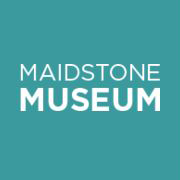Back to all posts
Life at the Museum – Beth Anderson

29th Nov 2016
By Maidstone Museum
What are your three favourite objects in the collection?
After a lot of thought, I finally have a selection! Interestingly, they are all ceramic wares.
Hiding behind the door of the Explorer’s gallery is a large Chinese crane. It is the only one of its kind on display. It has character, charm, a curious expression, and the brushwork is beautiful. In Asian history, notably in Japan and China, the crane is a symbol of happiness and longevity. There are a lot of cranes adorning the ceramics in the Japanese gallery.
Second, I have selected a tea set that dates from the late Edo Period to the early Meiji Period in Japan. Its maker was the ceramist and poet Otagaki Rengetsu, whose name translates to ‘Lotus Moon’. Like the crane, the lotus is a very popular and significant image in Asia, symbolising beauty, enlightenment, and rebirth. I researched this tea set whilst volunteering with Vanessa Totill, our Japanese expert, and wrote a blog piece about my findings. The tea set is currently on display in the Collectors Gallery, and you might be surprised how tiny it is! Each item in the five-piece set is hand-moulded and inscribed with a unique and beautiful poem.
My third item is a British-made tea and dinner set produced in the late 1950s. The iconic pattern was called Homemaker and was mass produced onto Metro design tableware. The Homemaker tableware was readily available and cheap to buy in Woolworths. During the 1950s, post-war Britain was reimagining itself. The images depict classic 1950s homewares and utensils. This emerging style of homewares is what we now call mid-century modern. It is still much loved, collected and influential. As such, ideas of longevity, beauty and rebirth – as symbolised in Eastern culture by the crane and lotus – are synonymous here also. The popularity of the Homemaker tea and dinner set has made it an iconic example of something new and exciting being born of a difficult, tragic period of British history.
If you could recommend one thing for a visitor to do at Maidstone Museum, what would it be and why?
First, make sure to visit the Japanese Gallery. It’s located in the east wing extension so it’s one of the only galleries to receive a lot of natural light, and it’s great to be aware of the seasons when you are in there. The collection gives a wonderful overview of Japan during the Meiji and Edo Periods, from Samurai armour and weaponry, to fine and delicate ceramic wares. Spend a bit of time considering any similarities and contrasts between Japan then and now. You might be surprised! Plus, it’s very calm in there.
What do you hope to see at Maidstone Museum in the future?
I would love to see a growing collection of late 20th and 21st-century objects, especially from a technological and design perspective. It’s great to think about how and when the objects, architecture and styles of our popular culture today might be acquired by the museum collection in the future. Talks, events and workshops around these ideas would be a lot of fun.

